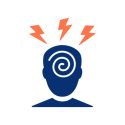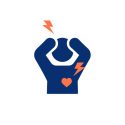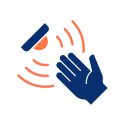The Mental Health Implications of Natural Disasters: Supporting Resilience and Recovery
In 2023, the Census Bureau estimated that nearly 2.5 million Americans were forced to leave their homes due to disasters, whether temporarily or for extended periods. Natural disasters such as earthquakes, hurricanes, wildfires, floods, and tornadoes not only cause physical devastation but also take a significant toll on mental health. These events can trigger or worsen a range of psychological, emotional, and behavioral responses in individuals and communities. Understanding these mental health impacts is crucial for creating support strategies that build resilience and promote long-term recovery.
In the aftermath of a natural disaster, survivors typically experience intense emotions. The immediate shock, fear, and anxiety can be overwhelming as individuals face the loss of homes, loved ones, or livelihoods. This initial stress response is natural and serves as a survival mechanism to cope with a sudden, life-altering event. Understanding typical emotional responses to disasters can aid in coping with the psychological impact and support the recovery process. In the immediate aftermath of a disaster, people often feel shocked, disoriented, or unable to process the event. After these initial reactions, various emotional and behavioral responses may emerge, including:

Intense or Unpredictable Emotions: Feelings of anxiety, nervousness, grief, or being overwhelmed are common. People may also experience increased irritability or mood swings.

Changes in Thoughts and Behavior: Survivors may have vivid, intrusive memories of the disaster, which can occur without warning and trigger physical reactions like a rapid heartbeat or sweating. Concentration and decision-making can become difficult, and disruptions in sleep or eating habits are common—some may overeat or oversleep, while others experience a loss of appetite and sleep.

Physical Symptoms: Stress can manifest physically, causing headaches, nausea, or chest pain. Preexisting medical conditions may worsen due to the stress of the event.

Heightened Sensitivity to Environmental Triggers: Sights, sounds, or smells associated with the disaster, such as sirens or smoke, may cause anxiety and fear of a repeat event.

Strained Relationships: Disaster survivors may find themselves more prone to conflicts with family, friends, or coworkers. Some may withdraw from social interactions or disengage from activities they once enjoyed.

Survivor’s Guilt: People who survived the disaster may feel guilty for their survival when others perished, leading to complicated emotional responses.

Displacement and Instability: Losing a home or being displaced can intensify feelings of helplessness and fear, complicating the path to mental health recovery.
Recognizing these responses is a crucial step in managing the emotional toll of a disaster and moving toward recovery. While the initial trauma of a natural disaster is immediate, the long-term mental health effects can persist for months or years. Survivors can develop Post-Traumatic Stress Disorder (PTSD), which may manifest through flashbacks, nightmares, and heightened states of arousal. Anxiety, depression, and substance use disorders are also common as individuals struggle to make sense of the disaster and rebuild their lives. However, the intensity of the trauma, combined with the uncertainty of what lies ahead, can lead to long-lasting psychological effects, especially if people do not have access to support services.
Certain populations are more likely to face mental health issues after a natural disaster. These include low-income communities, minorities, elders, and individuals with disabilities, who are disproportionately affected by such events. These groups often struggle with significant recovery challenges, such as limited access to resources and delayed rebuilding, which exacerbate their existing vulnerabilities. Researchers have found that not everyone is impacted in the same way and often times disasters expose broader social and economic inequities, underscoring the urgent need for more equitable recovery strategies to address disparities and provide better support for affected communities.
Resilience—the ability to adapt and recover from adversity—plays a critical role in mitigating the mental health effects of natural disasters. Effective recovery from natural disasters is often influenced by access to resources, the presence of strong community support, and accessible mental health resources. Communities with strong social bonds tend to recover more effectively. Support groups, community networks, and local mental health professionals can provide the necessary coping mechanisms for individuals to physically and emotionally rebuild, while access to practical resources helps promote a sense of safety and stability.
Strategies for Supporting Mental Health in the Wake of Natural Disasters
- Early Intervention: Identifying people at risk and providing immediate psychological support can prevent long-term mental health problems. Psychological first aid, crisis counseling, and mental health hotlines offer crucial support in the immediate aftermath of a disaster.
- Access to Mental Health Services: Providing trauma-informed mental health care, including therapy and counseling services, is essential for helping survivors process the event and manage ongoing stress.
- Public Awareness and Education: Communities should be educated on the common mental health responses to disasters, including the importance of seeking professional help. Normalizing these responses reduces stigma and encourages people to access services.
- Long-Term Recovery Plans: Mental health care should be integral to any long-term recovery plan. Support needs to continue well after the disaster is over, with resources in place for individuals who develop PTSD or other mental health challenges down the line.
- Support for First Responders: First responders must have access to mental health services that address the unique challenges of their roles. Peer support programs, therapy, and decompression time between deployments are critical in preventing burnout and trauma.
Natural disasters take a toll far beyond the immediate physical destruction, often leaving behind a legacy of mental health challenges. By recognizing these psychological impacts, we can prioritize mental health as part of disaster recovery efforts. Communities and individuals benefit when readily available mental health support fosters resilience and promotes healing. Empowering people to recover emotionally and physically is critical to building stronger, healthier communities that can weather the storm of future disasters.
If you or someone you know is experiencing emotional distress following a natural disaster, reach out to local mental health resources or national helplines to get support. Recovery is a journey, but no one should have to walk it alone.
Immediate help is available for those affected by or who may need additional assistance after experiencing a natural or human-created disaster. The Disaster Distress Helpline is a toll-free, multilingual crisis support service available 24/7 via telephone (1-800-985-5990) and SMS (text “TalkWithUs” to 66746). It is a federally funded resource provided by the Substance Abuse and Mental Health Services Administration.
References
American Psychological Association. (2013). Recovering emotionally from disaster. https://www.apa.org/topics/disasters-response/recovering
Kendra, J., & Wachtendorf, T. (2024). Who is displaced by hurricanes, wildfires and other disasters tells a story of vulnerability and recovery challenges in America. The Conversation. https://theconversation.com/who-is-displaced-by-hurricanes-wildfires-and-other-disasters-tells-a-story-of-vulnerability-and-recovery-challenges-in-america-224904
Makwana N. (2019). Disaster and its impact on mental health: A narrative review. Journal of family medicine and primary care, 8(10), 3090–3095. https://doi.org/10.4103/jfmpc.jfmpc_893_19
Substance Abuse and Mental Health Services Administration (SAMHSA). (2019). Disaster Distress Helpline Overview. https://www.samhsa.gov/find-help/disaster-distress-helpline.
World Health Organization. (2022). Mental health in emergencies. https://www.who.int/news-room/fact-sheets/detail/mental-health-in-emergencies
Blog Post Tags:
Related Blog Posts
Related Learning Labs
Related Resources
.
- Buscar Tratamiento de Calidad para Trastornos de uso de Sustancia (Finding Quality Treatment for Substance Use Disorders Spanish Version)
- Finding Quality Treatment for Substance Use Disorders
- Focus On Prevention: Strategies and Programs to Prevent Substance Use
- Monthly Variation in Substance Use Initiation Among Full-Time College Students
- The National Survey on Drug Use and Health (NSDUH) Report: Monthly Variation in Substance Use Initiation Among Adolescents








